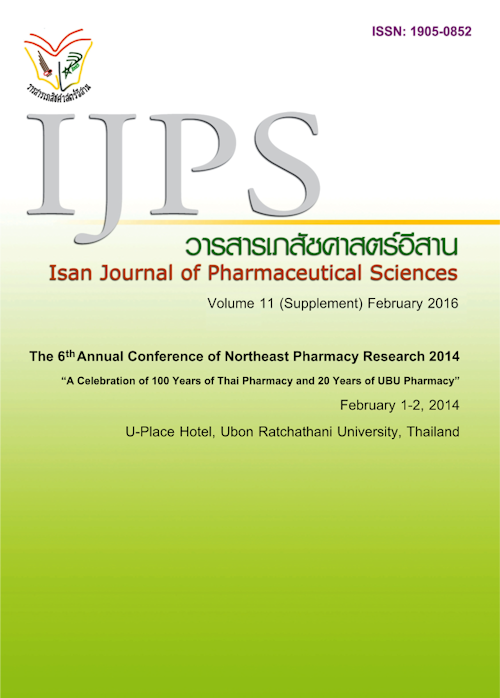High Dose Cefazolin for Entrapment in Interpenetrating Network Hydrogel Comprising of natural rubber and rice starch
Main Article Content
Abstract
Introduction: Interpenetrating network (IPN) hydrogel has a swelling and water absorption properties. This IPN hydrogel is possible to develop as a pharmaceutical material. Aim of this work is to study the cefazolin entrapment of IPN hydrogel comprising of natural rubber and rice starch. Materials and Method: IPN hydrogel was fabricated by free radical polymerization and evaluated swelling and water absorption properties by different weight method. IPN hydrogel structure was observed by scanning electron microscope (SEM). High-performance liquid chromatography (HPLC) technique was used to determine cefazolin content in this study. Results: IPN hydrogel from natural rubber and rice starch provided statistically a greater level of % swelling and % water absorption (70.92 ± 2.44 % and 41.49 ± 0.83 %, respectively) than pure rubber (5.71 ± 1.04 % and 5.39 ± 0.94 %, respectively) (p < 0.05). This result related to microscopic morphology of IPN hydrogel. Smooth surface and homogenous matrix with non-porous was seen for pure rubber while roughness surface with internal porous was appeared for IPN hydrogel. This structure of IPN hydrogel will lead to promote swelling and water absorption. With direct addition method for cefazolin entrapment, IPN hydrogel from natural rubber and rice starch provided statistically a greater cefazolin entrapment than pure rubber at the initial loading concentration 10 mg/ml (23.75 ± 1.05 % and 2.24 ± 0.76 %, respectively) (p < 0.05). Conclusion: IPN hydrogel from natural rubber and rice starch shows high swelling and water absorption due to the presence of the crosslinking network. Thus, IPN hydrogel is able to develop as a medical material.
Article Details
In the case that some parts are used by others The author must Confirm that obtaining permission to use some of the original authors. And must attach evidence That the permission has been included
References
Ferrer GG, Pradas MM, Ribelles JLG, Colomer FR, Castilla-Cortázar I, Vidaurre A. Influence of the nature of the porous confining network on the sorption, diffusion and mechanical properties of hydrogel IPNs. EurPolymJ2010; 46(4): 774–82.
Herculano RD, Alencar de Queiroz AA, Kinoshita A, Oliveira ON, Graeff CFO. On the release of metronidazole from natural rubber latex membranes. MaterSciEng2011; 31(2): 272–5.
Liu M, Su H, Tan T. Synthesis and properties of thermo-and pH-sensitive poly(N-isopropylacrylamide)/polyaspartic acid IPN hydrogels. CarbohydPolym 2012; 87(4): 2425–31.
Puapermpoonsiri U, Pratoomted J, Sila-On W, Watjung C. Water Absorption and Swelling Property of Interpenetrating Network Hydrogel from Crosslinked Natural Rubber and Modified Rice Starch. AdvMatRes 2014; 844: 73-76.
Sila-On W, Pratoomted J, Puapermpoonsiri U, Watjung C, Pitchayakorn W. Thermal and Mechanical Properties of Natural Rubber/Rice Starch Interpenetrating Network Hydrogel. AdvMatRes 2014; 844: 77-80.
Zou W, Yu L, Liu X, Chen L, Zhang X, Qiao D, et al. Effects of amylose/amylopectin ratio on starch-based superabsorbent polymers. Carbohyd Polym 2012; 87(2): 1583–8.


